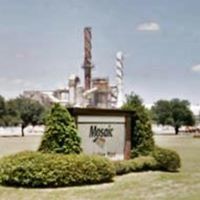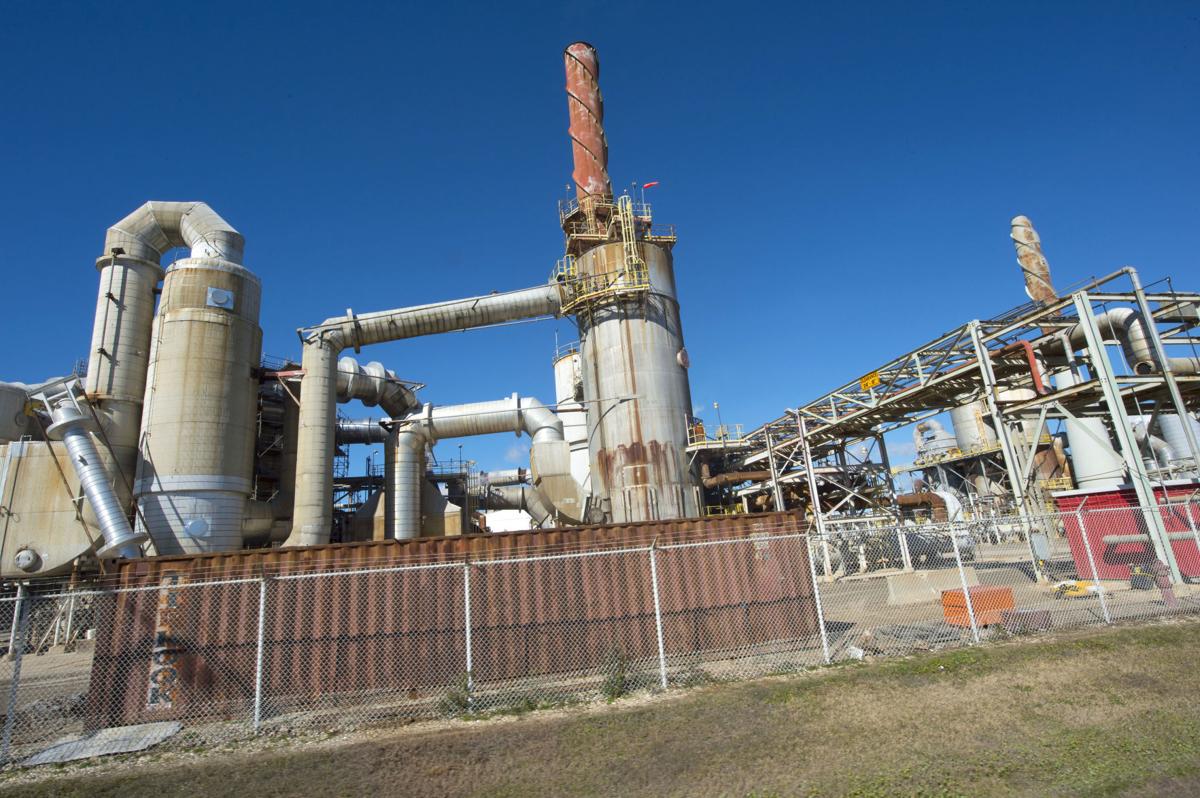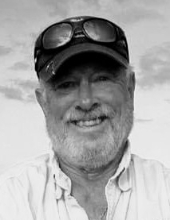Mosaic Uncle Sam
2004 – Original absorber tower replaced with MECS alloy tower
2009 – Original sulphur furnace replaced
– Original converter replaced, new 38 ft dia. MECS stainless steel converter
September 17. 2019 – Mosaic Co. is idling its Louisiana phosphates operations in St. James, cutting production by about 500,000 tons this year, as imports into the country have pushed down prices. The move is intended to speed up how fast Mosaic can empty its inventories, though the company expects “a more balanced global supply-and-demand picture to emerge by 2020.” Prices of the fertilizer ingredient have been under pressure since late 2018 as demand remains weak and capacity expansions in Morocco and Saudi Arabia have increased output and exports, Reuters reports. “Phosphate prices have declined further through the summer, with excess imports continuing to enter the U.S. on top of high channel inventories,” President and CEO Joc O’Rourke said in a statement. “We expect our move to idle production to tighten supply and rebalance the market. Mosaic will prioritize shipments to meet key customer needs through the idling period.” The company will also initiate $250 million in stock repurchases under its existing share repurchase authorization, which has $850 million of remaining capacity, according to the announcement. Mosaic operates its Faustina and Uncle Sam facilities in St. James Parish. At the Uncle Sam Facility, a turbo generator harnesses excess heat from sulfuric acid production. The cogeneration process allows Mosaic to harness “clean and green” energy. Uncle Sam produces phosphoric acid, which is then shipped across the river to the company’s Faustina facility, producing ammonia to make MAP, DAP and other products.
October 1, 2015 – EPA and the U.S. Department of Justice announced a settlement with Mosaic Fertilizer, LLC that will ensure the proper treatment, storage, and disposal of an estimated 60 billion pounds of hazardous waste at six Mosaic facilities in Florida and two in Louisiana. The settlement resolves a series of alleged violations by Mosaic, one of the world’s largest fertilizer manufacturers, of the federal Resource Conservation and Recovery Act (RCRA), which provides universal guidelines for how hazardous waste must be stored, handled and disposed. The 60 billion pounds of hazardous waste addressed in this case is the largest amount ever covered by a federal or state RCRA settlement and will ensure that wastewater at Mosaic’s facilities is properly managed and does not pose a threat to groundwater resources. The 60 billion pounds of hazardous waste is based on the combined amount of corrosive wastewaters that will be treated at terminal closure of the facilities. Mosaic is one of the fertilizers industry’s best performers in its ability to reduce large volumes of corrosive wastewater in its phosphogypsum stack systems. In addition to recovering valuable phosphate and other compounds, Mosaic is able to reduce terminal closure costs while ensuring that its phosphogypsum stack systems are operated in an environmentally safe manner. Four Mosaic facilities (New Wales, Bartow, Riverview in Florida and Uncle Sam in Louisiana) will continue to produce phosphoric acid and actively utilize its phosphogypsum stack systems. Mosaic is in the closure process for the Green Bay Complex and South Pierce facility in Florida, and the Faustina facility in Louisiana. However, Faustina will continue to manufacture ammoniated fertilizer. Mosaic operated a small sulfuric acid plant at the Mulberry facility in Florida for a short time. The Mulberry sulfuric acid plant was closed around 2008 and there are no obligations regarding this site in this settlement. Mosaic has been making major improvements at all its facilities and completed several notable projects: installation of state-of-the-art elementary neutralization units to improve the management of sulfuric acid waste streams, upgrading air scrubbers at its granulation and phosphoric acid plants, and installing automated spill and leak detection systems. All of these projects have been closely monitored by Florida Department of Environmental Protection, and Louisiana Department of Environmental Protection, who provided valuable expertise at each step of the process.
May 10, 2011 – The Mosaic Company today announced it will temporarily shut down its Louisiana operations due to the impact of the Mississippi River flooding on its electrical power supplies. Operations will resume when river water levels recede and conditions permit. The Company also noted that its ammonia plant at this location is temporarily idled for repairs following a recent incident. Mosaic’s Louisiana operations include Faustina, which produces diammonium phosphate and ammonia, and its Uncle Sam facility, which produces phosphoric, sulfuric and fluosilicic acid. These matters are not expected to have a material impact on Mosaic’s operations or financial results.
November 16, 2009 – The Mosaic Company (Mosaic) has contracted Cansolv Technologies Inc (Cansolv) an affiliate of Shell Global Solutions International B.V., to supply a modular CANSOLV SO2 Scrubbing System. The modular plant will capture SO2 from sulfuric acid plant tail gas at Mosaic’s Uncle Sam fertilizer production facility in Louisiana, USA. The CANSOLV SO2 Scrubbing System will be a key factor in enabling Mosaic to meet the SO2 reductions Mosaic has agreed to implement with its regulators. It is also the first regenerable technology of its kind to be installed in the fertilizer industry in the United States. The project award follows the successful implementation of the CANSOLV SO2 Scrubbing System in a wide range of industrial sectors with operating plants in the petrochemical, metallurgical and power industries. Mosaic has chosen to procure a pre-fabricated modular plant following an engineering study that demonstrated the cost-effectiveness of this approach. The expected delivery date of the modular plant is September 2010. The CANSOLV SO2 Scrubbing System is a new benchmark for environmental performance of sulfuric acid plants in the fertilizer industry. The technology will enable the Mosaic facility to meet SO2 emissions of 1 lb SO2/ton acid, while generating minimal liquid effluent. The Cansolv patented technology uses a regenerable amine to selectively absorb sulfur dioxide from the tail gas stream and recycles the pure SO2 by-product to the acid plant, maximizing productivity and minimizing liquid effluent.
October 10, 2009 – Mosaic Fertilizer agreed this week to give up its permit for a now-closed sulfuric acid production plant in Mulberry in partial settlement of a Clean Air Act action filed in federal court in New Orleans. It did not, as the Associated Press erroneously reported, agree to close its Bartow chemical plant, which remains in operation. The confusion, according to Russell Schweiss, public affairs manager for Mosaic, came from a reference to the Mulberry plant as being “near Bartow.” Mosaic shut down the Mulberry plant in 2008, Schweiss said. Mosaic, which has its corporate headquarters in Plymouth, Minn., is the last phosphate company still operating in Polk County. In the settlement, the company agreed to spend about $30 million to improve air pollution controls at its sulfuric acid plant near Baton Rouge, La., as well as to give up its permit for the Mulberry plant. Since that plant is closed, the settlement has no effect on any Mosaic opertions in Florida, Schweiss said. He said the upgrades at the Louisiana plant will include state-of-the-art scrubbers to capture sulfur dioxide emissions. The agreement also requires Mosaic to pay a $2.4 million civil penalty. Sulfur dioxide is emitted in the production of sulfuric acid, and in sufficient concentrations, can cause respiratory problems.
October 5, 2009 – Plymouth-based fertilizer giant Mosaic reported sharply lower profits for the first quarter amid a global sales slowdown of crop nutrients. In a release issued after trading closed Monday, the company reported sales of $1.46 billion, or 66 percent below last year’s first quarter sales of $4.32 billion. Earnings of $100.6 million for the quarter ending Aug. 31 were 92 percent below last year’s $1.18 billion and amounted to 23 cents per share. Analysts had expected earnings of 35 cents per share on sales of $1.54 billion. Sharp increases in fertilizer costs beginning last year, along with falling prices for some key agriculture commodities and the global recession, have thrown fertilizer sales into a tailspin. Mosaic’s industry rival, PotashCorp. of Saskatchewan, Inc., has scaled back its financial guidance several times this year. Mosaic, which produces fertilizer ingredients potash and phosphate, earlier this year declined to issue guidance “until market conditions normalize” on significant aspects of its business, including potash sales volumes and selling price. Cargill, the agribusiness titan and majority owner of Mosaic, warned in August that earnings had dropped at Mosaic. That same month, Mosaic officials said potash sales had fallen 35 to 40 percent, and phosphate sales were off 15 to 20 percent. The company’s long-term outlook remains positive because global demand for food, and thus the fertilizer needed to grow it, remains strong and rising. Projections of both population and calorie consumption show that farmers around the world must sharply increase their production to feed the planet. “Phosphate fundamentals have improved,” said James T. Prokopanko, company president and CEO. “The potash market is evolving and we expect strong demand in calendar year 2010 for both nutrients.”

MTPD – Metric Tonne per Day STPD – Short Ton per Day
MTPA – Metric Tonne per Annum STPA – Short Ton per Annum
SA – Single Absorption
DA – Double Absorption
* Coordinates can be used to locate plant on Google Earth
Copyright © 2005 -2011 DKL Engineering, Inc., All Rights Reserved
DKL Engineering, Inc. shall not be held liable for any type of damages resulting from the use of this information. The user assumes all risk and liability in connection with the use of information contained in this and associated web sites. The data is intended for personal, non-commercial use.



